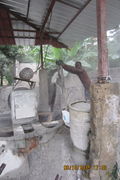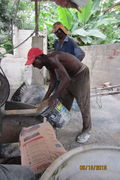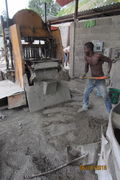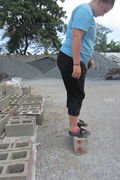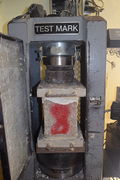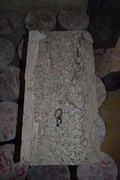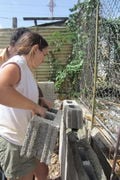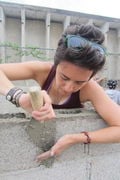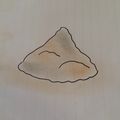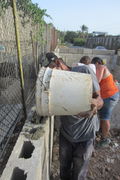Lexington333 (talk | contribs) (rice hulls cost money) |
Sophivorus (talk | contribs) m (Text replacement - "SDG11 Sustainable citites and communities" to "SDG11 Sustainable cities and communities") |
||
| (39 intermediate revisions by 11 users not shown) | |||
| Line 1: | Line 1: | ||
[[File:LasMalvinasChicas.jpeg|thumb | [[File:LasMalvinasChicas.jpeg|thumb|Las Malvinas team in front of the town's sign]] | ||
==Background== | {{Project data | ||
This project was included in Lonny Grafman's Practivistas summer program through Humboldt | | completed = 2015 | ||
}} | |||
{{Practivistas Dominicana menu}} | |||
This page discusses the Las Malvinas hullkrete project from summer, 2015. This project includes: designing and testing eco blocks in Las Malvinas that successfully fit the criteria set; and using the best eco blocks to finish as much of the already-started destacamento in Las Malvinas as possible. The project team is composed of a group of six students studying at Cal Poly Humboldt [http://humboldt.edu/ HSU], all of whom are members of Lonny Grafman's Practivistas program. | |||
== Background == | |||
This project was included in Lonny Grafman's Practivistas summer program through Cal Poly Humboldt. It took place from May 22-July 4, 2015 in the small community, Las Malvinas, located in the outskirts of Santo Domingo, Dominican Republic. The [https://web.archive.org/web/20210121205009/https://www.appropedia.org/Las_Malvinas_destacamento Las Malvinas destacamento 2014] began in 2014 and is expected to be finished in 2015. The team of six dug trenches to allow a place for the foundation as well as laid several blocks and rebar to create what is now a 4 foot tall perimeter with an overgrown inner area. This team hopes to complete the wall construction of the destacamento using eco friendly blocks. The decision of which blocks to be used will be made by testing several different recipes researched with the help of the block making factory owned by Vasquez, located in Las Malvinas. | |||
== Objective == | |||
The objective of this project is to construct the destacamento in Las Malvinas in the least carbon intensive way that utilizes as many waste resources as possible while providing education about resources used and creating a perfected recipe for the hullkrete ecoblocks that can then be commercially manufactured to boost the Las Malvinas economy. | |||
== | === Criteria === | ||
Below, a table of the criteria the hullkrete group decided upon is shown, each weighted with a value of importance: 10 being highest. The criteria is based off of the general consensus that the quantity of recipes for the blocks tested upon was of lesser importance than testing few known recipes and perfecting them so that they could be 1. commercially sold and produced and 2. could be used to build Las Malvina's destacamento. | |||
Below, a table of the criteria the hullkrete group decided upon is shown, each weighted with a value of importance: 10 being highest. The criteria is based off of the general consensus that the quantity of recipes for the blocks tested upon was of lesser importance than testing few known recipes and perfecting them so that they could be 1. commercially sold and produced and 2. could be used to build Las Malvina's destacamento. | |||
{| class="wikitable | {| class="wikitable" | ||
| | |+ Criteria and Description | ||
! Criteria | |||
! Weight | |||
! | ! Description | ||
! | |||
! | |||
|- | |- | ||
| Safety | | Safety | ||
| 10 | |||
| The structure must provide security for those using it as well as trust in the structure. | | The structure must provide security for those using it as well as trust in the structure. It is also important that the materials used to create the structure cause no harm to the public, or less harm than the standard, given that necessary safety precautions are taken. | ||
|- | |- | ||
| Durability | | Durability | ||
| 9 | |||
| The lifespan is suitable for the consumer given that the money needed to fix or replace the structure can be saved by the time the structure is in need. | | The lifespan is suitable for the consumer given that the money needed to fix or replace the structure can be saved by the time the structure is in need. The structure is also able to withstand the extremes of average weather conditions. | ||
|- | |- | ||
| Environmental Impact | | Environmental Impact | ||
| 9 | |||
| To have a less negative affect on the world than the standard that's commonly used. | | To have a less negative affect on the world than the standard that's commonly used. | ||
|- | |- | ||
| Aesthetics | | Aesthetics | ||
| 7 | |||
| Build a finished looking, smooth and trustworthy structure. | | Build a finished looking, smooth and trustworthy structure. | ||
|- | |- | ||
| Time | | Time | ||
| 6 | |||
| The importance of spending all of the constrained amount of time on a given project. | | The importance of spending all of the constrained amount of time on a given project. | ||
|- | |- | ||
| Cost | | Cost | ||
| 5 | |||
| The importance of spending all of the constrained amount of money on a given project. | | The importance of spending all of the constrained amount of money on a given project. | ||
|- | |- | ||
|Accesibility of Materials | | Accesibility of Materials | ||
| 5 | |||
|The time it takes to obtain a material must be within the constrained amount. | | The time it takes to obtain a material must be within the constrained amount. As well the ability to transport the material should be taken into consideration for whether it can be carried or delivered in that set amount of time. | ||
|} | |} | ||
== Literature Review == | == Literature Review == | ||
See [[Las Malvinas hullkrete 2015/Literature Review]] for the research done on this project. | See [[Las Malvinas hullkrete 2015/Literature Review]] for the research done on this project. | ||
==Construction== | == Construction == | ||
===Making Blocks=== | |||
=== Making Blocks === | |||
Below is a gallery displaying the steps taken to make blocks at Vasquez's factory. | Below is a gallery displaying the steps taken to make blocks at Vasquez's factory. | ||
<gallery> | |||
| | File:AnnetteSifting.JPG|Fig 1a: Sifting the wood ash obtained from the local distillery. Since it is a waste product it contained broken glass and several nails. | ||
File:ShovelingBucketRiceHulls.JPG|Fig 1b: Shoveling and using buckets to put rice hulls into the wheelbarrow. | |||
File:BlockMixing1.JPG|Fig 1c: All materials get poured into the mixer in a specific order, here is directly after rice hulls had been poured in. | |||
! | File:DustyAirBlocks.JPG|Fig 1d: Here is sand being put in the mixer. This photo displays the need for masks while working with blocks. | ||
! | File:PouringintoMixer.JPG|Fig 1e:Pouring wood ash into the mixer. | ||
File:TanyaSecante.JPG|Fig 1f: Tanya measuring secante to pour into our block mix. This was only used in our initial testing stage and was no longer used to produce blocks beyond the initial trials. | |||
File:ShovelingintoBlockMaker.JPG|Fig 1g: Shoveling the mix from the mixer into the block maker. | |||
File:BlockMaker1.JPG|Fig 1h: The very noisy block maker that shook and pushed down on the mix to form it into the shape of our blocks. | |||
File:FreshBlocks.JPG|Fig 1i: Fresh blocks right from the shaper. | |||
File:BrickSquad.JPG|Fig 1j: Using a dolly to transport the fresh blocks to our drying area. | |||
File:BlockMakingTeam.JPG|Fig 1k: The block making team feeling proud and tired. | |||
</gallery> | |||
=== Steps to Make Blocks === | |||
Initially the workers were adding the rice husks first because it was the most abundant material and the basis of our blocks. However, after about 2 batches they noticed that too much of the batch was getting stuck to the bottom of the machine and not being properly mixed and so the order was changed. | |||
{| class="wikitable" | |||
|+ How to Mix Materials into Block Machine | |||
! Steps | |||
! Description | |||
|- | |- | ||
! 1 Measure | ! 1 Measure | ||
| Measure out materials and have ready to put into machines. This has to be done in a group of at least 4. As soon as one wheel barrel is emptied it must be filled up ASAP because the workers work really fast. | | Measure out materials and have ready to put into machines. This has to be done in a group of at least 4. As soon as one wheel barrel is emptied it must be filled up ASAP because the workers work really fast. | ||
|- | |- | ||
! 2 Gravel | ! 2 Gravel | ||
| Line 100: | Line 102: | ||
|- | |- | ||
! 5 Powders | ! 5 Powders | ||
| This order varied depending on what was physically closest to the machine. What's important is that the cement and wood ash get poured in at the same time since the reason for using the ash is that it serves the same purpose as the concrete in the mix, acting as a pozzolan. | | This order varied depending on what was physically closest to the machine. What's important is that the cement and wood ash get poured in at the same time since the reason for using the ash is that it serves the same purpose as the concrete in the mix, acting as a pozzolan. | ||
|- | |- | ||
! 6 Cement & Wood Ash | ! 6 Cement & Wood Ash | ||
| Line 109: | Line 111: | ||
|} | |} | ||
===Testing Blocks=== | === Testing Blocks === | ||
If not given the opportunity to formally test blocks, a manual test can be done to see how easily the blocks can be broke, chipped or cracked. | If not given the opportunity to formally test blocks, a manual test can be done to see how easily the blocks can be broke, chipped or cracked. | ||
<gallery> | |||
File:CrunchyBlocks.JPG|Fig 1a: Some of our blocks were fairly easy to chip off, this was due to the high content of rice hulls. | |||
File:LexieBlockTest.JPG|Fig 1b: Lexie using her feet to see if the blocks can be chipped off easily. Also jumping on both ends of the blocks to see if and how the blocks break. | |||
File:BlockinMachine.JPG|Fig 1c: Our highest preforming block, recipe 5, of the first set of test blocks in a compression tester. This compression tester located at P&R Ingeniería on Av. San Martin, Santo Domingo. | |||
File:CrackedBlock.JPG|Fig 1d: Resulting crack from the compression tester on our highest preforming block, recipe 5. | |||
</gallery> | |||
=== Applying Blocks === | |||
<gallery> | |||
===Applying Blocks=== | File:AnnettePuttingMortar.JPG|Fig 1a: Annette placing two mortar layers on the outer edges of the already applied layer of blocks. | ||
File:KaileighStruggling.JPG|Fig 1b: Kaileigh lifting a block to place it on the mortar layer. | |||
File:AnnetteApplyingMortar.JPG|Fig 1c: After the block has been placed, mortar is fit in between the blocks. | |||
</gallery> | |||
=== Filling Blocks === | |||
<gallery> | |||
File:MountainStyle.JPG | Fig 1a: Not an actual picture, but the best way to mix the fill mixture is to shovel it all into the center like a mountain and then make a volcano. This was done about 5 times, mountain to volcano, mountain to volcano, until it was all about the same color, and then the water is added. | |||
File:VolcanoSquad.JPG | Fig 1b: A mini volcano of mixing materials. | |||
File: BlockFillVolcano.JPG |Fig 1c: The dry fill mixture, now in volcano style ready to be mixed with a shovel and pickax. | |||
File: MixingFillWithShovel.JPG |Fig 1d: Gregorio is mixing the fill mixture with a shovel which is extremely tedious and difficult. | |||
File: WettingByHand.JPG|Fig 1e: Gregorio is blending the mixture as someone uses their hands to add water little bit little. | |||
File: GregorioPickaxingFill.JPG |Fig f: Here Gregorio is using the pickax to blend the mixture because its a lot easier to move through the gravel in this way. | |||
File: PouringFillDown.JPG| Fig 1g: Pouring the fill mixture down the blocks we had just laid. | |||
</gallery> | |||
==Timeline== | == Timeline == | ||
The following is a list of the tasks assigned and achieved as well as the dates. | The following is a list of the tasks assigned and achieved as well as the dates. | ||
{| class="wikitable | {| class="wikitable" | ||
|+ Timeline | |||
! Date | |||
! Tasks | |||
|- | |- | ||
! | ! 28 May 2015 | ||
| Community meeting at Las Malvinas II | |||
|- | |- | ||
! | ! 29 May 2015 | ||
| Meeting with Eddie at Las Malvinas II | |||
* Took notes on current state of Destacamento: how many blocks, current square footage | |||
|Meeting with Eddie at Las Malvinas II | |||
*Took notes on current state of Destacamento: how many blocks, current square footage | |||
|- | |- | ||
! 06 June 2015 | |||
|UNIBE Architecture camping day | | UNIBE Architecture camping day | ||
|- | |- | ||
! 11 June 2015 | |||
|Distillery is no longer powered by rice hull, and now uses wood. | | Distillery is no longer powered by rice hull, and now uses wood. Will be collecting wood ash tomorrow | ||
|- | |- | ||
! 12 June 2015 | |||
|Accompanied Enrique to the distillery and filled a wheelbarrow with wood ash | | Accompanied Enrique to the distillery and filled a wheelbarrow with wood ash | ||
|- | |- | ||
! 13 June 2015 | |||
| | | | ||
*Bought supplies to get ready for block making | |||
*Double-sifted wood ash | * Bought supplies to get ready for block making | ||
*Unable to get rice hulls today, postponed to Monday the 15th | * Double-sifted wood ash | ||
* Unable to get rice hulls today, postponed to Monday the 15th | |||
|- | |- | ||
! 15 June 2015 | |||
|Accompanied Antonio and Jose to a rice factory approximately an hour away to obtain rice hulls | | Accompanied Antonio and Jose to a rice factory approximately an hour away to obtain rice hulls | ||
|- | |- | ||
! 17 June 2015 | |||
|Returned to factory to get more rice hulls | | Returned to factory to get more rice hulls | ||
|- | |- | ||
! 18 June 2015 | |||
|Began making blocks; executed 6 different recipes, making a total of 188 blocks | | Began making blocks; executed 6 different recipes, making a total of 188 blocks | ||
|- | |- | ||
! 19 June 2015 | |||
| | | | ||
*Calculated recipe materials needed to finish the destacamento including the area and the amount of blocks | |||
*Created a timeline with potential future workdays at Vasquez's site to be able to make the blocks we need | * Calculated recipe materials needed to finish the destacamento including the area and the amount of blocks | ||
* Created a timeline with potential future workdays at Vasquez's site to be able to make the blocks we need | |||
|- | |- | ||
! 20 June 2015 | |||
|Beach day, required relaxation | | Beach day, required relaxation | ||
|- | |- | ||
! 21 June 2015 | |||
| | | | ||
*Began leveling the ground in the destacamento and cleaning general area within and outside of building | |||
*Split up into groups: one group for plastering the botica and cleaning the floors, and the second group for more block making. | * Began leveling the ground in the destacamento and cleaning general area within and outside of building | ||
* Split up into groups: one group for plastering the botica and cleaning the floors, and the second group for more block making. | |||
|- | |- | ||
! 22 June 2015 | |||
| | | | ||
*Went to block factory to make another order in preparation for making blocks the next day | |||
*Went to local distillery, which had been supplying wood ash for the blocks; however, they said they are unable to give us the ash due to it being recently (and possibly temporarily) shut down. | * Went to block factory to make another order in preparation for making blocks the next day | ||
* Went to local distillery, which had been supplying wood ash for the blocks; however, they said they are unable to give us the ash due to it being recently (and possibly temporarily) shut down. | |||
|- | |- | ||
! 23 June 2015 | |||
| | | | ||
*Organized blocks into piles of the same type | |||
*Did standing, jumping and kicking tests on each of the blocks and noted their responses | * Organized blocks into piles of the same type | ||
*Designed the iterations on the two strongest recipes to try for this round of block making | * Did standing, jumping and kicking tests on each of the blocks and noted their responses | ||
*Power went out and were unable to make blocks, planned to make more on Thursday | * Designed the iterations on the two strongest recipes to try for this round of block making | ||
* Power went out and were unable to make blocks, planned to make more on Thursday | |||
|- | |- | ||
! 25 June 2015 | |||
| | | | ||
*Arrived at block factory at agreed upon time, machine or power left and wouldn't be back until the 26th | |||
*New plan decided for Saturday 27 June at 1pm and Sunday 28 June 9am to make blocks, shook hands to agree upon time and goal of 600 blocks | * Arrived at block factory at agreed upon time, machine or power left and wouldn't be back until the 26th | ||
* New plan decided for Saturday 27 June at 1pm and Sunday 28 June 9am to make blocks, shook hands to agree upon time and goal of 600 blocks | |||
|- | |- | ||
! 27 June 2015 | |||
| | | | ||
*Arrived at the block factory at 1pm, was told the man who runs the machine wont be back until 2pm, then at 2pm we were told to come back at 4pm, and by that time we knew we weren't able to make blocks. | |||
*At around 7pm as we are walking through the town working on other projects when a man we've never met before stopped us to let us know we'd be able to make blocks the next day, Sunday the 28 | * Arrived at the block factory at 1pm, was told the man who runs the machine wont be back until 2pm, then at 2pm we were told to come back at 4pm, and by that time we knew we weren't able to make blocks. | ||
* At around 7pm as we are walking through the town working on other projects when a man we've never met before stopped us to let us know we'd be able to make blocks the next day, Sunday the 28 of June, at 9am | |||
|- | |- | ||
! 28 June 2015 | |||
| | | | ||
*Arrived at the block factory at 9:15am with the workers having said they looked for us and are ready to build | |||
*Made 492 blocks out of two different recipes with natural iterations | * Arrived at the block factory at 9:15am with the workers having said they looked for us and are ready to build | ||
*Obtained rebar from the president of the neighborhood watch who has said that if blocks were available to build up the destacamento, she would put pressure on to get it built | * Made 492 blocks out of two different recipes with natural iterations | ||
*Made mortar and put up a little less than two rows of blocks on to the destacamento | * Obtained rebar from the president of the neighborhood watch who has said that if blocks were available to build up the destacamento, she would put pressure on to get it built | ||
* Made mortar and put up a little less than two rows of blocks on to the destacamento | |||
|- | |- | ||
! 30 June 2015 | |||
| | | | ||
*Although the blocks from Sunday, 28 of June are ready, the president of the neighborhood watch community said that it would be best to not have them delivered to the destacamento | |||
*Purchased more material for mortar | * Although the blocks from Sunday, 28 of June are ready, the president of the neighborhood watch community said that it would be best to not have them delivered to the destacamento | ||
*Added another two rows of blocks to the destacamento's back wall- realized that some of less durable blocks had already been added in the previous work day to the holding cell | * Purchased more material for mortar | ||
* Added another two rows of blocks to the destacamento's back wall- realized that some of less durable blocks had already been added in the previous work day to the holding cell | |||
|} | |} | ||
=== Costs === | |||
Below is a table of the costs associated with this hullkrete project. | |||
Below is a table of the costs associated with this hullkrete project. | |||
{|class="wikitable | {| class="wikitable" | ||
|+ Cost of materials | |||
! Material | |||
! Source | |||
! Quantity | |||
! Costo (RD$) | |||
! Cost ($) | |||
|- | |- | ||
| Saco de Paja de Arroz | |||
| Molino La Estrella | |||
| 30 | |||
| 300 | |||
| 6.68 | |||
|- | |- | ||
| Transportación para Paja de Arroz | |||
| Molino La Estrella | |||
| 1 | |||
| 500 | |||
| 11.14 | |||
|- | |- | ||
| | | Spray Paint | ||
| | | Ferreteria La Formula | ||
| | | 1 | ||
| 100 | |||
| 2.23 | |||
|- | |- | ||
| | | Trabajadores para 4 horas | ||
| | | Ferreteria Vasquez Martes | ||
| | | 1 | ||
| 3000 | |||
| 67.13 | |||
|- | |- | ||
| | | Metero Cúbico de Arena | ||
| | | Ferreteria Vasquez Martes | ||
| | | 1 | ||
| 800 | |||
| 17.83 | |||
|- | |- | ||
| | | Carretilla de Caliche | ||
| | | Ferreteria Vasquez Martes | ||
| | | 3 | ||
| 270 | |||
| 6.02 | |||
|- | |- | ||
| | | Carretilla de Gravilla | ||
| | | Ferreteria Vasquez Martes | ||
| | | 3 | ||
| 270 | |||
| 6.02 | |||
|- | |- | ||
| Carretilla de | | Carretilla de Arena | ||
| Ferreteria Vasquez Martes | |||
| 3 | |||
| 270 | |||
| 6.02 | |||
|- | |- | ||
| | | Fundas de Cemento | ||
| | | Ferreteria Vasquez Martes | ||
| | | 12 | ||
| 2760 | |||
| 61.76 | |||
|- | |- | ||
| | | Trabajadores para 600 bloques | ||
| | | Ferreteria Vasquez Martes | ||
| | | 1 | ||
| 6500 | |||
| 144.75 | |||
|- | |- | ||
| Fundas de Cemento | | Fundas de Cemento | ||
| | | Ferreteria Vasquez Martes | ||
| | | 17 | ||
| 3740 | |||
| 83.29 | |||
|- | |- | ||
| | | Carretilla de Arena | ||
| | | Ferreteria Vasquez Martes | ||
| | | 8 | ||
| 1000 | |||
| 22.27 | |||
|- | |- | ||
| | | Carretilla de Caliche | ||
| | | Ferreteria Vasquez Martes | ||
| | | 15 | ||
| 1200 | |||
| 26.72 | |||
|- | |- | ||
| Carretilla de | | Carretilla de Gravilla | ||
| | | Ferreteria Vasquez Martes | ||
| | | 8 | ||
| 720 | |||
| 16.03 | |||
|- | |- | ||
| | | Spray de Pintura | ||
| | | Ferreteria Suazo | ||
| | | 1 | ||
| 75 | |||
| 1.67 | |||
|- | |- | ||
| | | 10lb Funda de Cal | ||
| | | Ferreteria Suazo | ||
| | | 2 | ||
| 120 | |||
| 2.67 | |||
|- | |- | ||
| | | Funda de Cal | ||
| | | Ferreteria y Fab. de Block el Progreso | ||
| | | 10 | ||
| 550 | |||
| 12.25 | |||
|- | |- | ||
| | | Compresión Pruebas para los Bloques | ||
| P&R Ingeniería | |||
| 9 | |||
| 5400 | |||
| 120.19 | |||
|- | |- | ||
| | | colspan="3"|Total | ||
| 27575 | |||
| 614.67 | |||
|} | |||
==== Recreation Cost Recipe 6 ==== | |||
The following table describes the cost to make 11 batches of recipe number 6 which yielded 340 blocks. | The following table describes the cost to make 11 batches of recipe number 6 which yielded 340 blocks. | ||
{|class="wikitable | |||
{| class="wikitable" | |||
|+ Costo de Receta Bloque 6 (11 lotes) | |||
! Material | |||
! Costo Total(RD$) | |||
! Costo por Bloque(RD$) | |||
|- | |- | ||
| Cáscara de Arroz | |||
| 40 | |||
| 0.12 | |||
|- | |- | ||
| Caliche | |||
| 880 | |||
| 2.59 | |||
|- | |- | ||
| | | Arena y Tabo | ||
| | | 688 | ||
| | | 2.02 | ||
|- | |- | ||
| | | Gravilla | ||
| | | 995 | ||
| 2.93 | |||
|- | |- | ||
| | | Cal | ||
| | | 605 | ||
| | | 1.78 | ||
|- | |- | ||
| | | Cemento Portland | ||
| | | 2420 | ||
| | | 7.12 | ||
|- | |- | ||
| | | Ceniza de Madera | ||
| | | 0 | ||
| | | 0 | ||
|- | |- | ||
| Total | |||
| 5628 | |||
| 16.56 | |||
|Total | |||
| | |||
| | |||
|} | |} | ||
====Recreation Cost Recipe 9==== | ==== Recreation Cost Recipe 9 ==== | ||
The following table describes the cost to make 11 batches of recipe number 9 which yielded 152 blocks. | The following table describes the cost to make 11 batches of recipe number 9 which yielded 152 blocks. | ||
{|class="wikitable | |||
{| class="wikitable" | |||
|+ Costo de Receta Bloque 9 (4 lotes) | |||
! Material | |||
! Costo Total(RD$) | |||
! Costo por Bloque(RD$) | |||
|- | |- | ||
| Cáscara de Arroz | |||
| 110 | |||
| 0.72 | |||
|- | |- | ||
| Caliche | |||
| 320 | |||
| 2.10 | |||
|- | |- | ||
| | | Arena y Tabo | ||
| | | 500 | ||
| | | 3.29 | ||
|- | |- | ||
| | | Gravilla | ||
| | | 360 | ||
| 2.38 | |||
|- | |- | ||
| | | Cal | ||
| | | 220 | ||
| | | 1.45 | ||
|- | |- | ||
| | | Cemento Portland | ||
| | | 440 | ||
| 2.89 | |||
|- | |- | ||
| Total | |||
| 1950 | |||
| 12.83 | |||
|Total | |||
|} | |} | ||
===Tests=== | === Tests === | ||
====Recipe 6==== | |||
==== Recipe 6 ==== | |||
Using the following recipe for 11 batches, 340 blocks were made | Using the following recipe for 11 batches, 340 blocks were made | ||
{| class="wikitable | |||
{| class="wikitable" | |||
|+ Block Recipe 6 | |||
! Quantity | |||
! Type | |||
! Description | |||
! Material | |||
! Prep time | |||
! Cost($) | |||
|- | |- | ||
| 1 | |||
| Wheelbarrow | |||
| Filled to brim | |||
| Ricehull | |||
| 3hr total drive time to obtain | |||
| 0 | |||
|- | |- | ||
| 1 | |||
| Wheelbarrow | |||
| Overly full | |||
| Caliche | |||
| 0 | |||
| 1.78 | |||
|- | |- | ||
| 1/2 | |||
|Wheelbarrow | | Wheelbarrow | ||
| | | Overly full | ||
| | | Sand | ||
| | | 0 | ||
| | | 1.39 | ||
|- | |- | ||
| 1/2 | |||
|Wheelbarrow | | Wheelbarrow | ||
|Overly full | | Overly full | ||
| | | Gravel | ||
| 0 | |||
| 1.00 | |||
|- | |- | ||
| 1 | |||
| | | 5kg Bag | ||
| | | Oxidized | ||
| | | Lime | ||
| | | 40 minute maximum car ride | ||
| 1.22 | |||
|- | |- | ||
| 1 | |||
| 94lb Bag | |||
|94lb Bag | |||
| | | | ||
|Portland Cement | | Portland Cement | ||
| 0 | |||
| 4.90 | |||
|- | |- | ||
| 1 | |||
|5gal Bucket | | 5gal Bucket | ||
|Most poured initially, less than 25% saved for the end of the batch | | Most poured initially, less than 25% saved for the end of the batch | ||
|Wood Ash | | Wood Ash | ||
|5hr total time to walk with wheelbarrow and double sift (enough for 11 batches) | | 5hr total time to walk with wheelbarrow and double sift (enough for 11 batches) | ||
| 0 | |||
|} | |} | ||
====Recipe 9==== | ==== Recipe 9 ==== | ||
Using the following recipe for 4 batches, 152 blocks were made | Using the following recipe for 4 batches, 152 blocks were made | ||
{| class="wikitable | |||
{| class="wikitable" | |||
|+ Block Recipe 9 | |||
! Quantity | |||
! Type | |||
! Description | |||
! Material | |||
! Prep time | |||
! Cost($) | |||
|- | |- | ||
| 1 | |||
| Wheelbarrow | |||
| Filled to brim | |||
| Ricehull | |||
| 3hr total drive time to obtain | |||
| 0 | |||
|- | |- | ||
| 1 | |||
| Wheelbarrow | |||
| Overly full | |||
| Caliche | |||
| 0 | |||
| 1.78 | |||
|- | |- | ||
| 1 | |||
|Wheelbarrow | | Wheelbarrow | ||
| | | Overly full | ||
| | | Sand | ||
| | | 0 | ||
| | | 1.39 | ||
|- | |- | ||
| 1 | |||
|Wheelbarrow | | Wheelbarrow | ||
|Overly full | | Overly full | ||
| | | Gravel | ||
| 0 | |||
| 1.00 | |||
|- | |- | ||
| 1 | |||
| | | 5kg Bag | ||
| | | Oxidized | ||
| | | Lime | ||
| | | 40 minute maximum car ride | ||
| 1.22 | |||
|- | |- | ||
| 1/2 | |||
| 94lb Bag | |||
|94lb Bag | |||
| | | | ||
|Portland Cement | | Portland Cement | ||
| 0 | |||
| 4.90 | |||
|} | |||
=== Testing results === | |||
Below, are the recipes used for the Eco Blocks and their results from the compression test performed on them. | Below, are the recipes used for the Eco Blocks and their results from the compression test performed on them. | ||
Please note, each batch produced roughly 24-40 blocks, with multiple rounds each producing 4 blocks at a time. | |||
Each batch had an extra amount of cement added into the last couple rounds whose mixture was on the bottom and received less cement initially. This was done with the workers discretion, so recorded quantities are not exact. | |||
{| class="wikitable | {| class="wikitable" | ||
| | |+ Block Recipes | ||
! Material | |||
! Type of Measurement | |||
! | ! Recipe 1 Block 1 | ||
! | ! Recipe 1 Added Cement | ||
! | ! Recipe 2 | ||
! | ! Recipe 3 | ||
! | ! Recipe 3 Added Cement | ||
! | ! Recipe 4 | ||
! | ! Recipe 5 | ||
! | ! Recipe 5 Added Cement | ||
! | ! Recipe 6 | ||
! | |||
! | |||
|- | |- | ||
| Ricehull | | Ricehull | ||
| | | 5 gallon buckets | ||
| | | 12 | ||
| | | 12 | ||
| | | 12 | ||
| | | 12 | ||
| | | 12 | ||
| | | 12 | ||
| | | 12 | ||
| | | 12 | ||
| | | 4 heaping | ||
|- | |- | ||
| Caliche | | Caliche | ||
| | | 5 gallon buckets | ||
| | | 0 | ||
| | | 0 | ||
| | | 0 | ||
| | | 3 | ||
| | | 3 | ||
| | | 3 | ||
| | | 3 | ||
| | | 3 | ||
| | | 4 | ||
|- | |- | ||
| Sand | | Sand | ||
| | | 5 gal bucket | ||
| | | 1 | ||
| | | 1 | ||
| | | 1 | ||
| | | 1 | ||
| | | 1 | ||
| | | 1 | ||
| | | 2 | ||
| | | 2 | ||
| | | 2 | ||
|- | |- | ||
| Gravel | | Gravel | ||
| | | 5 gal bucket | ||
| | | 0.5 | ||
| | | 0.5 | ||
| | | 1 | ||
| | | 1 | ||
| | | 1 | ||
| | | 1 | ||
| | | 2 | ||
| | | 2 | ||
| | | 2 | ||
|- | |- | ||
| Lime | | Lime | ||
| 5kg Bag | | 5kg Bag | ||
| | | 1 | ||
| | | 1 | ||
| | | 1 | ||
| | | 1 | ||
| | | 1 | ||
| | | 1 | ||
| | | 1 | ||
| | | 1 | ||
| | | 2 | ||
|- | |- | ||
| Cement | | Cement | ||
| 94lb Bag | | 94lb Bag | ||
| | | 1.25 | ||
| | | <math>+</math>0.25 | ||
| | | 1 (<math>+</math>.25 bag for last 20 blocks to get cement on dregs of batch that didn't receive as much) | ||
| | | 1 | ||
| | | <math>+</math> 2 shovelfuls for last 8 blocks | ||
| | | 1 (<math>+</math>.2 shovelfuls for last 16 or so blocks) | ||
| | | 1 | ||
| | | <math>+</math>0.5 bag for last 8 blocks | ||
| | | 1 bag for whole batch | ||
|- | |- | ||
| Wood Ash | | Wood Ash | ||
| 5gal Bucket | | 5gal Bucket | ||
| | | 0 | ||
| | | 0 | ||
| | | 1 | ||
| | | 2 | ||
| | | 2 | ||
| | | 0 | ||
| | | 0 (simply because ran out) | ||
| | | 0 | ||
| | | 0 | ||
|- | |||
| Batch indicator | |||
| Symbol sprayed on each block (*Note: batches with added cement marked with original symbol plus single dot except in first batch*) | |||
| Line along edge <math>+</math> single dot | |||
| Line along edge | |||
| line along middle (added cement portion marked with additional single dot) | |||
| T | |||
| T <math>+</math> single dot | |||
| Two vertical dots (added cement contains extra dot) | |||
| Diagonal line | |||
| Diagonal line <math>+</math> single dot | |||
| Infinity sign (or 8) | |||
|- | |- | ||
| colspan="2 | | colspan="2"|Weight (kg) | ||
| 5.52 | | 5.52 | ||
| 5.49 | | 5.49 | ||
| Line 647: | Line 705: | ||
| 6.45 | | 6.45 | ||
|- | |- | ||
| colspan="2 | | colspan="2"|Surface Area (cm<sup>2</sup>) | ||
| 576.00 | | 576.00 | ||
| 580.65 | | 580.65 | ||
| Line 658: | Line 716: | ||
| 578.16 | | 578.16 | ||
|- | |- | ||
| colspan="2 | | colspan="2"|Breaking Load (kg) | ||
| 2680.00 | | 2680.00 | ||
| 2520.00 | | 2520.00 | ||
| Line 669: | Line 727: | ||
| 4580.00 | | 4580.00 | ||
|- | |- | ||
| colspan="2 | | colspan="2"|Breaking Stress (kg/cm<sup>2</sup>) | ||
| 4.65 | | 4.65 | ||
| 4.34 | | 4.34 | ||
| Line 682: | Line 740: | ||
=== Maintenance === | === Maintenance === | ||
=== | Maintenance for the destacamento and building blocks include different requirements based upon if the destacamento is going to be built in the near future. It would be best not to keep the eco blocks outside in the weather: sun and rain, day after day if the destacamento is going to be finished being built later on. Also, if the destacamento is going to be delayed being finished, the now somewhat leveled earth floors need to be upkept in that people need to refrain from throwing their basura, trash, into the building- otherwise, the ground will start to build up trash mounds again. However, if the destacamento is going to be built sooner rather than later, plastering should occur as soon as the walls are put up to protect the eco blocks from being at all degraded by the weather and surroundings. | ||
== Conclusion == | |||
=== Testing results === | |||
Recipe 5 preformed the best in our compression tests, this, we believe is due to recipe 5 having half the amount of rice hull than the first recipes. | |||
=== Discussion === | |||
After our first set of test blocks were made, we were able to conduct physical tests with our feet to determine the strength and what patterns we could find involving rice hull content and strength. Since we were unable to conduct professional tests on our initial test blocks before making more, we used what we learned from our feet tests to decide the recipe to use next. Our second and final time at the block factory we made blocks with a new recipe which was an iteration based on our recipe 5 which preformed the best. We also used the information we learned about the previous recipes to make the iteration. After these blocks were made, we were able to test our initial set of six recipes and were able to officially deduce that recipe 5 was the strongest and was approximately 30% as strong as the Dominican Republic's government requires blocks to be. | |||
== | === Lessons learned === | ||
There are a plethora of lessons learned from this project. One crucial lesson learned was to plan better. Many times trying to coordinate making eco blocks at Vasquez's factory failed because of a miscommunication of when his space and workers were accessible, and also due to not having all of the necessary supplies. It would have been way more efficient to have the entire group sit down and choose a known recipe to start with and then start making variations of recipes with lists of materials and how many blocks were desired to make in the day and quantities of materials needed to do so. Vasquez's factory is open Monday-Saturday, morning until mid to late afternoon, so the only available times the group was able to work was either full-day Sundays or part-days in the afternoons after the factory closes. The workers hired to help the team make the blocks needed to be notified and asked to stay for pay, and they expected all of the eco block materials to be at the factory and ready to go the day before. Some of the key ingredients to this year's blocks were rice hulls and wood ash. The rice hulls were located an hour away from the community, so a driver with a truck was needed, and the wood ash was off and on available at the local distillery in Las Malvinas- but needed to be sifted twice, which could take several hours depending on how much was needed. These mistakes should be read by future Practivistas students wanting to do more exploring with the blocks. | |||
There are a plethora of lessons learned from this project. One crucial lesson learned was to plan better. Many times trying to coordinate making eco blocks at Vasquez's factory failed because of a miscommunication of when his space and workers were accessible, and also due to not having all of the necessary supplies. It would have been way more efficient to have the entire group sit down and choose a known recipe to start with and then start making variations of recipes with lists of materials and how many blocks were desired to make in the day and quantities of materials needed to do so. Vasquez's factory is open Monday-Saturday, morning until mid to late afternoon, so the only available times the group was able to work was either full-day Sundays or part-days in the afternoons after the factory closes. The workers hired to help the team make the blocks needed to be notified and asked to stay for pay, and they expected all of the eco block materials to be at the factory and ready to go the day before. Some of the key ingredients to this year's blocks were rice hulls and wood ash. The rice hulls were located an hour away from the community, so a driver with a truck was needed, and the wood ash was off and on available at the local distillery in Las Malvinas- but needed to be sifted twice, which could take several hours depending on how much was needed. These mistakes should be read by future Practivistas students wanting to do more exploring with the blocks. | |||
With the destacamento, it is important to have someone- generally a community member- who knowns what he/she is doing. Someone who excels at building is crucial because there are a lot of aspects to be considered: such as leveling the blocks before adding all of the mortar, or where to add rebar, or how full to pour the mortar down the block holes. This was a lesson learned when two group members showed up at the destacamento ready to finish some layers of wall and soon realized they didn't know quite what they were doing at all. It is important to learn and listen to community members who are experts in the fields of work. | With the destacamento, it is important to have someone- generally a community member- who knowns what he/she is doing. Someone who excels at building is crucial because there are a lot of aspects to be considered: such as leveling the blocks before adding all of the mortar, or where to add rebar, or how full to pour the mortar down the block holes. This was a lesson learned when two group members showed up at the destacamento ready to finish some layers of wall and soon realized they didn't know quite what they were doing at all. It is important to learn and listen to community members who are experts in the fields of work. | ||
===Next steps=== | === Next steps === | ||
So now that the building and planning and experimenting is done for the team, what are the next steps? For the community or future Practivistas students, this means more experimenting with making blocks with different variations of materials as well as finish building the destacamento. Building the destacamento with the eco blocks made is important because it makes the building more "green" and locally resourced. If a recipe is found for the eco blocks that is exceptionally efficient, maybe the community and beyond can grow to be more locally resourced and environmental. | So now that the building and planning and experimenting is done for the team, what are the next steps? For the community or future Practivistas students, this means more experimenting with making blocks with different variations of materials as well as finish building the destacamento. Building the destacamento with the eco blocks made is important because it makes the building more "green" and locally resourced. If a recipe is found for the eco blocks that is exceptionally efficient, maybe the community and beyond can grow to be more locally resourced and environmental. | ||
=== | === Current State === | ||
The Natural Building team succeeded their goal in an ecological friendly block recipe. The recipe reduces the normal cement content thus cutting costs of manufacture. The blocks were set through compression tests; ones that passed the compression tests were used to continue construction of the destacamento. | |||
As far as the destacamento goes, the image below depicts the before and after shot of the progress made towards building this summer. The amount of work done to this building this summer is significant. | |||
| | |||
[[File: First destac.JPG|thumb|left|El destacamento BEFORE any work was done to it this summer: pile of trash, some blocks stacked]] | |||
[[File: After destac.JPG|thumb|center|El destacamento AFTER work done to it this summer: floor flattened, trash picked up, more stacked blocks]] | |||
== Video: Building a Destacamento == | |||
{{Video|5pedjSFh87U}} | |||
== Team == | |||
[[File:Fuerte.jpg|thumb|The Powderpuff Girls. Plus Isabel and Lonny.]] | |||
The Las Malvinas natural building team, Practivistas 2015: | |||
* [[User:Henry Chinaski|Carley Bramhill]] | |||
* [[User:Lexington333|Lexie Folkerts]] | |||
* [[User:Ttg37|Tanya Garcia]] | |||
* [[User:Aen131|Allison Nerby]] | |||
* [[User:APenny6|Annette Penny]] | |||
* [[User:Kgv40|Kaileigh Vincent-Welling]] | |||
{{Page data | |||
| sdg = SDG11 Sustainable cities and communities | |||
| published = 2015 | |||
| license = CC-BY-SA-3.0 | |||
| language = en | |||
}} | |||
[[Category:Practivistas Dominicana Program]] | [[Category:Practivistas Dominicana Program]] | ||
[[Category:Construction]] | |||
Latest revision as of 09:29, 30 November 2022
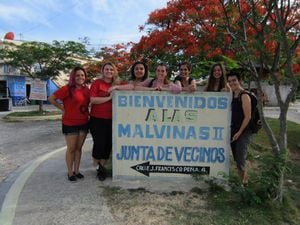
This page discusses the Las Malvinas hullkrete project from summer, 2015. This project includes: designing and testing eco blocks in Las Malvinas that successfully fit the criteria set; and using the best eco blocks to finish as much of the already-started destacamento in Las Malvinas as possible. The project team is composed of a group of six students studying at Cal Poly Humboldt HSU, all of whom are members of Lonny Grafman's Practivistas program.
Background[edit | edit source]
This project was included in Lonny Grafman's Practivistas summer program through Cal Poly Humboldt. It took place from May 22-July 4, 2015 in the small community, Las Malvinas, located in the outskirts of Santo Domingo, Dominican Republic. The Las Malvinas destacamento 2014 began in 2014 and is expected to be finished in 2015. The team of six dug trenches to allow a place for the foundation as well as laid several blocks and rebar to create what is now a 4 foot tall perimeter with an overgrown inner area. This team hopes to complete the wall construction of the destacamento using eco friendly blocks. The decision of which blocks to be used will be made by testing several different recipes researched with the help of the block making factory owned by Vasquez, located in Las Malvinas.
Objective[edit | edit source]
The objective of this project is to construct the destacamento in Las Malvinas in the least carbon intensive way that utilizes as many waste resources as possible while providing education about resources used and creating a perfected recipe for the hullkrete ecoblocks that can then be commercially manufactured to boost the Las Malvinas economy.
Criteria[edit | edit source]
Below, a table of the criteria the hullkrete group decided upon is shown, each weighted with a value of importance: 10 being highest. The criteria is based off of the general consensus that the quantity of recipes for the blocks tested upon was of lesser importance than testing few known recipes and perfecting them so that they could be 1. commercially sold and produced and 2. could be used to build Las Malvina's destacamento.
| Criteria | Weight | Description |
|---|---|---|
| Safety | 10 | The structure must provide security for those using it as well as trust in the structure. It is also important that the materials used to create the structure cause no harm to the public, or less harm than the standard, given that necessary safety precautions are taken. |
| Durability | 9 | The lifespan is suitable for the consumer given that the money needed to fix or replace the structure can be saved by the time the structure is in need. The structure is also able to withstand the extremes of average weather conditions. |
| Environmental Impact | 9 | To have a less negative affect on the world than the standard that's commonly used. |
| Aesthetics | 7 | Build a finished looking, smooth and trustworthy structure. |
| Time | 6 | The importance of spending all of the constrained amount of time on a given project. |
| Cost | 5 | The importance of spending all of the constrained amount of money on a given project. |
| Accesibility of Materials | 5 | The time it takes to obtain a material must be within the constrained amount. As well the ability to transport the material should be taken into consideration for whether it can be carried or delivered in that set amount of time. |
Literature Review[edit | edit source]
See Las Malvinas hullkrete 2015/Literature Review for the research done on this project.
Construction[edit | edit source]
Making Blocks[edit | edit source]
Below is a gallery displaying the steps taken to make blocks at Vasquez's factory.
-
Fig 1a: Sifting the wood ash obtained from the local distillery. Since it is a waste product it contained broken glass and several nails.
-
Fig 1b: Shoveling and using buckets to put rice hulls into the wheelbarrow.
-
Fig 1c: All materials get poured into the mixer in a specific order, here is directly after rice hulls had been poured in.
-
Fig 1d: Here is sand being put in the mixer. This photo displays the need for masks while working with blocks.
-
Fig 1e:Pouring wood ash into the mixer.
-
Fig 1f: Tanya measuring secante to pour into our block mix. This was only used in our initial testing stage and was no longer used to produce blocks beyond the initial trials.
-
Fig 1g: Shoveling the mix from the mixer into the block maker.
-
Fig 1h: The very noisy block maker that shook and pushed down on the mix to form it into the shape of our blocks.
-
Fig 1i: Fresh blocks right from the shaper.
-
Fig 1j: Using a dolly to transport the fresh blocks to our drying area.
-
Fig 1k: The block making team feeling proud and tired.
Steps to Make Blocks[edit | edit source]
Initially the workers were adding the rice husks first because it was the most abundant material and the basis of our blocks. However, after about 2 batches they noticed that too much of the batch was getting stuck to the bottom of the machine and not being properly mixed and so the order was changed.
| Steps | Description |
|---|---|
| 1 Measure | Measure out materials and have ready to put into machines. This has to be done in a group of at least 4. As soon as one wheel barrel is emptied it must be filled up ASAP because the workers work really fast. |
| 2 Gravel | Its the material with the widest radius and therefore should go in first. |
| 3 Sand & Caliche | Mix in the sand next because it has the 2nd largest radius. Because our recipe called for 1/2 a wheel barrel of sand and 1/2 wheel barrel of gravel, we put them in the same wheel barrel and poured them in together. However when we did separate wheel barrels, the sand and caliche alternated between going 2nd and 3rd. |
| 4 Rice husks | The rice husks are very light and are used for tensile strength and should go after all the sediment. |
| 5 Powders | This order varied depending on what was physically closest to the machine. What's important is that the cement and wood ash get poured in at the same time since the reason for using the ash is that it serves the same purpose as the concrete in the mix, acting as a pozzolan. |
| 6 Cement & Wood Ash | You want to mix these in together and they should be at the top of the batch because if they are poured in too early they will just stick to the bottom of the machine and be wasted. |
| 7 Lime | The lime was normally pour in last or before the other powders, but just needs to be on top because it's a fine powder. Make sure to wear googles and a mask because your lungs will hurt. |
Testing Blocks[edit | edit source]
If not given the opportunity to formally test blocks, a manual test can be done to see how easily the blocks can be broke, chipped or cracked.
-
Fig 1a: Some of our blocks were fairly easy to chip off, this was due to the high content of rice hulls.
-
Fig 1b: Lexie using her feet to see if the blocks can be chipped off easily. Also jumping on both ends of the blocks to see if and how the blocks break.
-
Fig 1c: Our highest preforming block, recipe 5, of the first set of test blocks in a compression tester. This compression tester located at P&R Ingeniería on Av. San Martin, Santo Domingo.
-
Fig 1d: Resulting crack from the compression tester on our highest preforming block, recipe 5.
Applying Blocks[edit | edit source]
-
Fig 1a: Annette placing two mortar layers on the outer edges of the already applied layer of blocks.
-
Fig 1b: Kaileigh lifting a block to place it on the mortar layer.
-
Fig 1c: After the block has been placed, mortar is fit in between the blocks.
Filling Blocks[edit | edit source]
-
Fig 1a: Not an actual picture, but the best way to mix the fill mixture is to shovel it all into the center like a mountain and then make a volcano. This was done about 5 times, mountain to volcano, mountain to volcano, until it was all about the same color, and then the water is added.
-
Fig 1b: A mini volcano of mixing materials.
-
Fig 1c: The dry fill mixture, now in volcano style ready to be mixed with a shovel and pickax.
-
Fig 1d: Gregorio is mixing the fill mixture with a shovel which is extremely tedious and difficult.
-
Fig 1e: Gregorio is blending the mixture as someone uses their hands to add water little bit little.
-
Fig f: Here Gregorio is using the pickax to blend the mixture because its a lot easier to move through the gravel in this way.
-
Fig 1g: Pouring the fill mixture down the blocks we had just laid.
Timeline[edit | edit source]
The following is a list of the tasks assigned and achieved as well as the dates.
| Date | Tasks |
|---|---|
| 28 May 2015 | Community meeting at Las Malvinas II |
| 29 May 2015 | Meeting with Eddie at Las Malvinas II
|
| 06 June 2015 | UNIBE Architecture camping day |
| 11 June 2015 | Distillery is no longer powered by rice hull, and now uses wood. Will be collecting wood ash tomorrow |
| 12 June 2015 | Accompanied Enrique to the distillery and filled a wheelbarrow with wood ash |
| 13 June 2015 |
|
| 15 June 2015 | Accompanied Antonio and Jose to a rice factory approximately an hour away to obtain rice hulls |
| 17 June 2015 | Returned to factory to get more rice hulls |
| 18 June 2015 | Began making blocks; executed 6 different recipes, making a total of 188 blocks |
| 19 June 2015 |
|
| 20 June 2015 | Beach day, required relaxation |
| 21 June 2015 |
|
| 22 June 2015 |
|
| 23 June 2015 |
|
| 25 June 2015 |
|
| 27 June 2015 |
|
| 28 June 2015 |
|
| 30 June 2015 |
|
Costs[edit | edit source]
Below is a table of the costs associated with this hullkrete project.
| Material | Source | Quantity | Costo (RD$) | Cost ($) |
|---|---|---|---|---|
| Saco de Paja de Arroz | Molino La Estrella | 30 | 300 | 6.68 |
| Transportación para Paja de Arroz | Molino La Estrella | 1 | 500 | 11.14 |
| Spray Paint | Ferreteria La Formula | 1 | 100 | 2.23 |
| Trabajadores para 4 horas | Ferreteria Vasquez Martes | 1 | 3000 | 67.13 |
| Metero Cúbico de Arena | Ferreteria Vasquez Martes | 1 | 800 | 17.83 |
| Carretilla de Caliche | Ferreteria Vasquez Martes | 3 | 270 | 6.02 |
| Carretilla de Gravilla | Ferreteria Vasquez Martes | 3 | 270 | 6.02 |
| Carretilla de Arena | Ferreteria Vasquez Martes | 3 | 270 | 6.02 |
| Fundas de Cemento | Ferreteria Vasquez Martes | 12 | 2760 | 61.76 |
| Trabajadores para 600 bloques | Ferreteria Vasquez Martes | 1 | 6500 | 144.75 |
| Fundas de Cemento | Ferreteria Vasquez Martes | 17 | 3740 | 83.29 |
| Carretilla de Arena | Ferreteria Vasquez Martes | 8 | 1000 | 22.27 |
| Carretilla de Caliche | Ferreteria Vasquez Martes | 15 | 1200 | 26.72 |
| Carretilla de Gravilla | Ferreteria Vasquez Martes | 8 | 720 | 16.03 |
| Spray de Pintura | Ferreteria Suazo | 1 | 75 | 1.67 |
| 10lb Funda de Cal | Ferreteria Suazo | 2 | 120 | 2.67 |
| Funda de Cal | Ferreteria y Fab. de Block el Progreso | 10 | 550 | 12.25 |
| Compresión Pruebas para los Bloques | P&R Ingeniería | 9 | 5400 | 120.19 |
| Total | 27575 | 614.67 | ||
Recreation Cost Recipe 6[edit | edit source]
The following table describes the cost to make 11 batches of recipe number 6 which yielded 340 blocks.
| Material | Costo Total(RD$) | Costo por Bloque(RD$) |
|---|---|---|
| Cáscara de Arroz | 40 | 0.12 |
| Caliche | 880 | 2.59 |
| Arena y Tabo | 688 | 2.02 |
| Gravilla | 995 | 2.93 |
| Cal | 605 | 1.78 |
| Cemento Portland | 2420 | 7.12 |
| Ceniza de Madera | 0 | 0 |
| Total | 5628 | 16.56 |
Recreation Cost Recipe 9[edit | edit source]
The following table describes the cost to make 11 batches of recipe number 9 which yielded 152 blocks.
| Material | Costo Total(RD$) | Costo por Bloque(RD$) |
|---|---|---|
| Cáscara de Arroz | 110 | 0.72 |
| Caliche | 320 | 2.10 |
| Arena y Tabo | 500 | 3.29 |
| Gravilla | 360 | 2.38 |
| Cal | 220 | 1.45 |
| Cemento Portland | 440 | 2.89 |
| Total | 1950 | 12.83 |
Tests[edit | edit source]
Recipe 6[edit | edit source]
Using the following recipe for 11 batches, 340 blocks were made
| Quantity | Type | Description | Material | Prep time | Cost($) |
|---|---|---|---|---|---|
| 1 | Wheelbarrow | Filled to brim | Ricehull | 3hr total drive time to obtain | 0 |
| 1 | Wheelbarrow | Overly full | Caliche | 0 | 1.78 |
| 1/2 | Wheelbarrow | Overly full | Sand | 0 | 1.39 |
| 1/2 | Wheelbarrow | Overly full | Gravel | 0 | 1.00 |
| 1 | 5kg Bag | Oxidized | Lime | 40 minute maximum car ride | 1.22 |
| 1 | 94lb Bag | Portland Cement | 0 | 4.90 | |
| 1 | 5gal Bucket | Most poured initially, less than 25% saved for the end of the batch | Wood Ash | 5hr total time to walk with wheelbarrow and double sift (enough for 11 batches) | 0 |
Recipe 9[edit | edit source]
Using the following recipe for 4 batches, 152 blocks were made
| Quantity | Type | Description | Material | Prep time | Cost($) |
|---|---|---|---|---|---|
| 1 | Wheelbarrow | Filled to brim | Ricehull | 3hr total drive time to obtain | 0 |
| 1 | Wheelbarrow | Overly full | Caliche | 0 | 1.78 |
| 1 | Wheelbarrow | Overly full | Sand | 0 | 1.39 |
| 1 | Wheelbarrow | Overly full | Gravel | 0 | 1.00 |
| 1 | 5kg Bag | Oxidized | Lime | 40 minute maximum car ride | 1.22 |
| 1/2 | 94lb Bag | Portland Cement | 0 | 4.90 |
Testing results[edit | edit source]
Below, are the recipes used for the Eco Blocks and their results from the compression test performed on them. Please note, each batch produced roughly 24-40 blocks, with multiple rounds each producing 4 blocks at a time. Each batch had an extra amount of cement added into the last couple rounds whose mixture was on the bottom and received less cement initially. This was done with the workers discretion, so recorded quantities are not exact.
| Material | Type of Measurement | Recipe 1 Block 1 | Recipe 1 Added Cement | Recipe 2 | Recipe 3 | Recipe 3 Added Cement | Recipe 4 | Recipe 5 | Recipe 5 Added Cement | Recipe 6 |
|---|---|---|---|---|---|---|---|---|---|---|
| Ricehull | 5 gallon buckets | 12 | 12 | 12 | 12 | 12 | 12 | 12 | 12 | 4 heaping |
| Caliche | 5 gallon buckets | 0 | 0 | 0 | 3 | 3 | 3 | 3 | 3 | 4 |
| Sand | 5 gal bucket | 1 | 1 | 1 | 1 | 1 | 1 | 2 | 2 | 2 |
| Gravel | 5 gal bucket | 0.5 | 0.5 | 1 | 1 | 1 | 1 | 2 | 2 | 2 |
| Lime | 5kg Bag | 1 | 1 | 1 | 1 | 1 | 1 | 1 | 1 | 2 |
| Cement | 94lb Bag | 1.25 | 0.25 | 1 (.25 bag for last 20 blocks to get cement on dregs of batch that didn't receive as much) | 1 | 2 shovelfuls for last 8 blocks | 1 (.2 shovelfuls for last 16 or so blocks) | 1 | 0.5 bag for last 8 blocks | 1 bag for whole batch |
| Wood Ash | 5gal Bucket | 0 | 0 | 1 | 2 | 2 | 0 | 0 (simply because ran out) | 0 | 0 |
| Batch indicator | Symbol sprayed on each block (*Note: batches with added cement marked with original symbol plus single dot except in first batch*) | Line along edge single dot | Line along edge | line along middle (added cement portion marked with additional single dot) | T | T single dot | Two vertical dots (added cement contains extra dot) | Diagonal line | Diagonal line single dot | Infinity sign (or 8) |
| Weight (kg) | 5.52 | 5.49 | 7.13 | 8.68 | 8.66 | 8.83 | 10.15 | 11.36 | 6.45 | |
| Surface Area (cm2) | 576.00 | 580.65 | 557.20 | 568.80 | 578.16 | 588.00 | 574.20 | 575.65 | 578.16 | |
| Breaking Load (kg) | 2680.00 | 2520.00 | 4700.00 | 6060.00 | 6180.00 | 10080.00 | 12320.00 | 12920.00 | 4580.00 | |
| Breaking Stress (kg/cm2) | 4.65 | 4.34 | 8.44 | 10.65 | 10.69 | 17.14 | 21.46 | 22.44 | 7.92 | |
Maintenance[edit | edit source]
Maintenance for the destacamento and building blocks include different requirements based upon if the destacamento is going to be built in the near future. It would be best not to keep the eco blocks outside in the weather: sun and rain, day after day if the destacamento is going to be finished being built later on. Also, if the destacamento is going to be delayed being finished, the now somewhat leveled earth floors need to be upkept in that people need to refrain from throwing their basura, trash, into the building- otherwise, the ground will start to build up trash mounds again. However, if the destacamento is going to be built sooner rather than later, plastering should occur as soon as the walls are put up to protect the eco blocks from being at all degraded by the weather and surroundings.
Conclusion[edit | edit source]
Testing results[edit | edit source]
Recipe 5 preformed the best in our compression tests, this, we believe is due to recipe 5 having half the amount of rice hull than the first recipes.
Discussion[edit | edit source]
After our first set of test blocks were made, we were able to conduct physical tests with our feet to determine the strength and what patterns we could find involving rice hull content and strength. Since we were unable to conduct professional tests on our initial test blocks before making more, we used what we learned from our feet tests to decide the recipe to use next. Our second and final time at the block factory we made blocks with a new recipe which was an iteration based on our recipe 5 which preformed the best. We also used the information we learned about the previous recipes to make the iteration. After these blocks were made, we were able to test our initial set of six recipes and were able to officially deduce that recipe 5 was the strongest and was approximately 30% as strong as the Dominican Republic's government requires blocks to be.
Lessons learned[edit | edit source]
There are a plethora of lessons learned from this project. One crucial lesson learned was to plan better. Many times trying to coordinate making eco blocks at Vasquez's factory failed because of a miscommunication of when his space and workers were accessible, and also due to not having all of the necessary supplies. It would have been way more efficient to have the entire group sit down and choose a known recipe to start with and then start making variations of recipes with lists of materials and how many blocks were desired to make in the day and quantities of materials needed to do so. Vasquez's factory is open Monday-Saturday, morning until mid to late afternoon, so the only available times the group was able to work was either full-day Sundays or part-days in the afternoons after the factory closes. The workers hired to help the team make the blocks needed to be notified and asked to stay for pay, and they expected all of the eco block materials to be at the factory and ready to go the day before. Some of the key ingredients to this year's blocks were rice hulls and wood ash. The rice hulls were located an hour away from the community, so a driver with a truck was needed, and the wood ash was off and on available at the local distillery in Las Malvinas- but needed to be sifted twice, which could take several hours depending on how much was needed. These mistakes should be read by future Practivistas students wanting to do more exploring with the blocks.
With the destacamento, it is important to have someone- generally a community member- who knowns what he/she is doing. Someone who excels at building is crucial because there are a lot of aspects to be considered: such as leveling the blocks before adding all of the mortar, or where to add rebar, or how full to pour the mortar down the block holes. This was a lesson learned when two group members showed up at the destacamento ready to finish some layers of wall and soon realized they didn't know quite what they were doing at all. It is important to learn and listen to community members who are experts in the fields of work.
Next steps[edit | edit source]
So now that the building and planning and experimenting is done for the team, what are the next steps? For the community or future Practivistas students, this means more experimenting with making blocks with different variations of materials as well as finish building the destacamento. Building the destacamento with the eco blocks made is important because it makes the building more "green" and locally resourced. If a recipe is found for the eco blocks that is exceptionally efficient, maybe the community and beyond can grow to be more locally resourced and environmental.
Current State[edit | edit source]
The Natural Building team succeeded their goal in an ecological friendly block recipe. The recipe reduces the normal cement content thus cutting costs of manufacture. The blocks were set through compression tests; ones that passed the compression tests were used to continue construction of the destacamento.
As far as the destacamento goes, the image below depicts the before and after shot of the progress made towards building this summer. The amount of work done to this building this summer is significant.
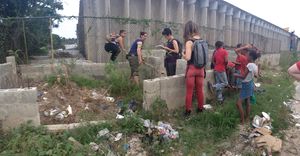
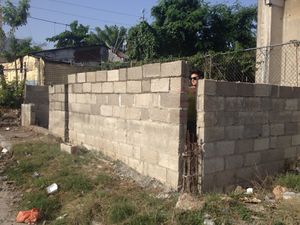
Video: Building a Destacamento[edit | edit source]
Team[edit | edit source]
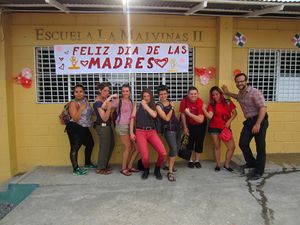
The Las Malvinas natural building team, Practivistas 2015:



